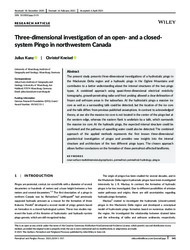Three‐dimensional investigation of an open‐ and a closed‐system Pingo in northwestern Canada
DOI: https://doi.org/10.1002/ppp.2115
Persistent URL: http://resolver.sub.uni-goettingen.de/purl?gldocs-11858/9887
Persistent URL: http://resolver.sub.uni-goettingen.de/purl?gldocs-11858/9887
Kunz, Julius; Kneisel, Christof, 2021: Three‐dimensional investigation of an open‐ and a closed‐system Pingo in northwestern Canada. In: Permafrost and Periglacial Processes, Band 32, 4: 541 - 557, DOI: 10.1002/ppp.2115.
 |
Dokument öffnen: |
The present study presents three‐dimensional investigations of a hydrostatic pingo in the Mackenzie Delta region and a hydraulic pingo in the Ogilvie Mountains and contributes to a better understanding about the internal structures of the two pingo types. A combined approach using quasi‐three‐dimensional electrical resistivity tomography, ground‐penetrating radar and frost probing allowed a clear delineation of frozen and unfrozen areas in the subsurface. At the hydrostatic pingo a massive ice core as well as a surrounding talik could be detected, but the location of the ice core and the talik differs from previous published assumptions. In contrast to acknowledged theory, at our site the massive ice core is not located in the center of the pingo but at the western edge, whereas the eastern flank is underlain by a talik, which surrounds the massive ice core. At the hydraulic pingo, the expected internal structure could be confirmed and the pathway of upwelling water could also be detected. The combined approach of the applied methods represents the first known three‐dimensional geoelectrical investigation of pingos and provides new insights into the internal structure and architecture of the two different pingo types. The chosen approach allows further conclusions on the formation of these permafrost‐affected landforms.
Statistik:
ZugriffsstatistikSammlung:
This is an open access article under the terms of the Creative Commons Attribution‐NonCommercial‐NoDerivs License, which permits use and distribution in any medium, provided the original work is properly cited, the use is non‐commercial and no modifications or adaptations are made.

